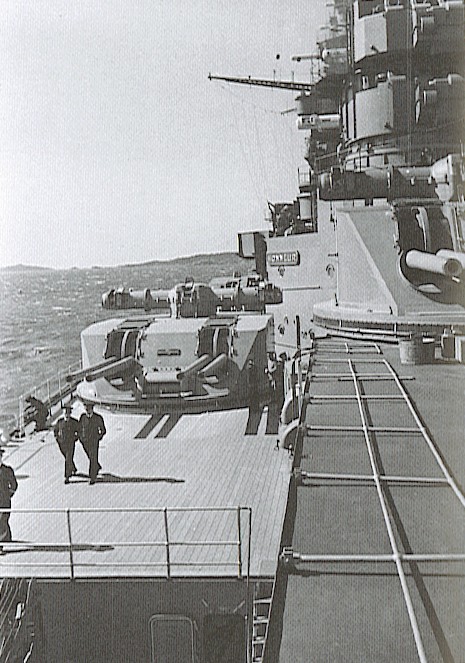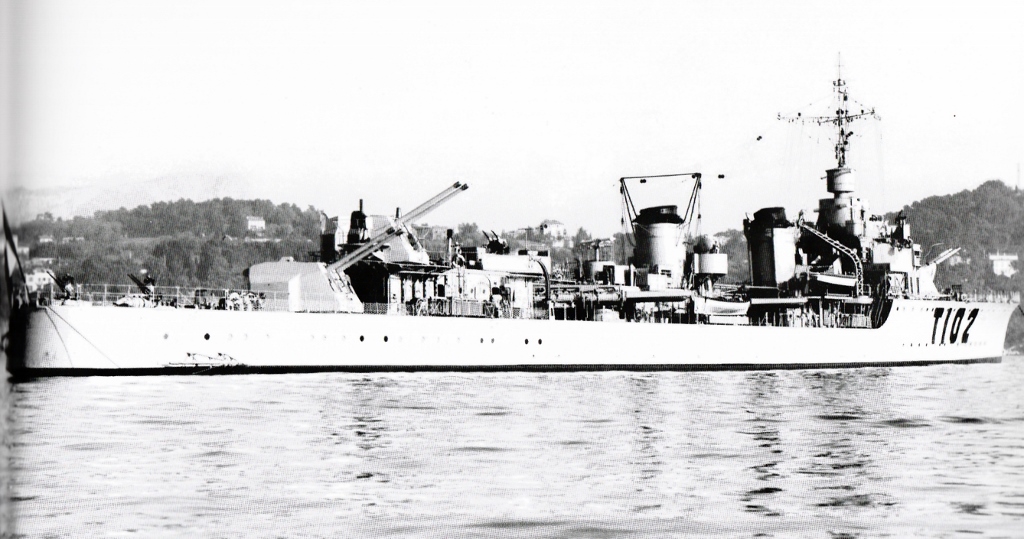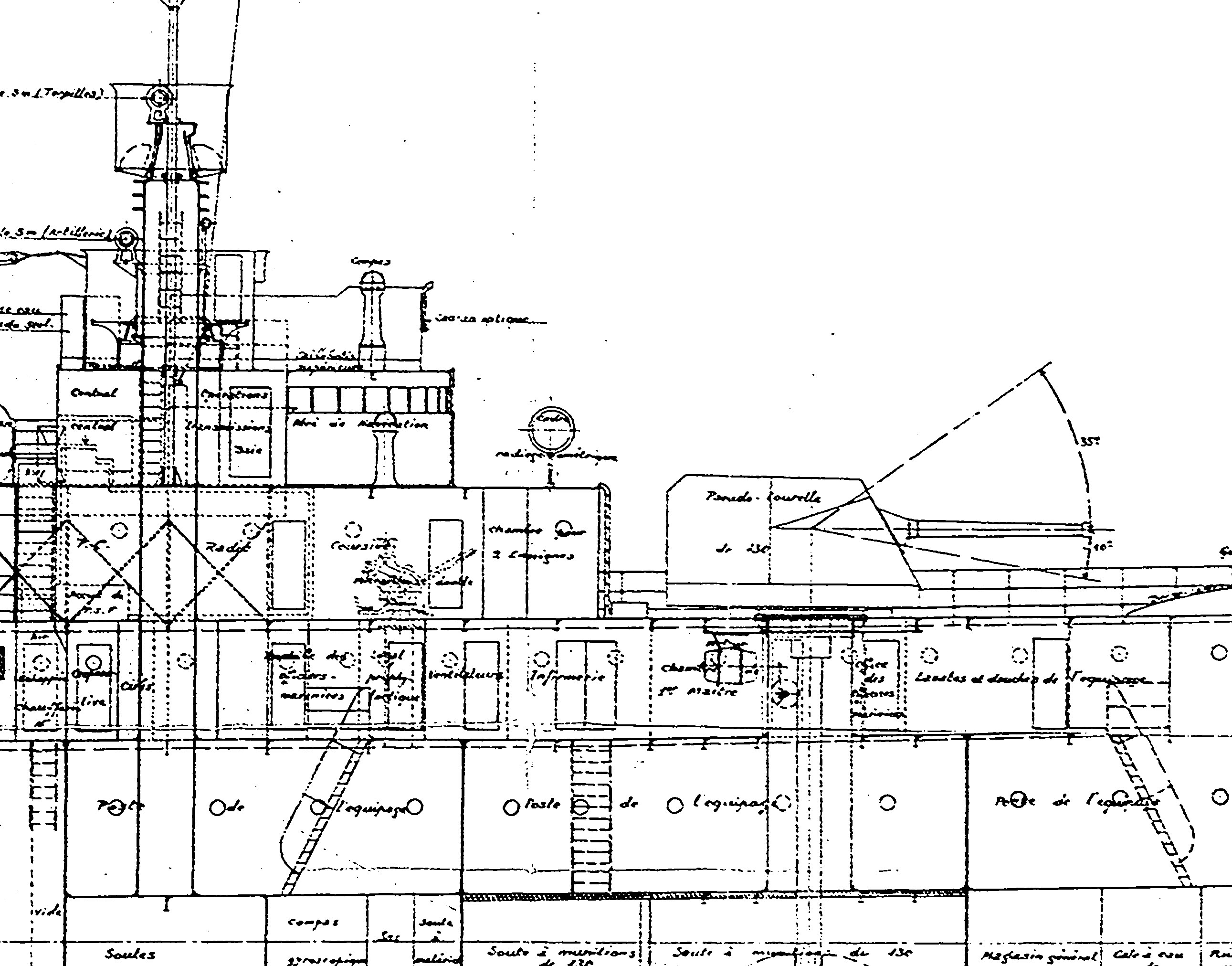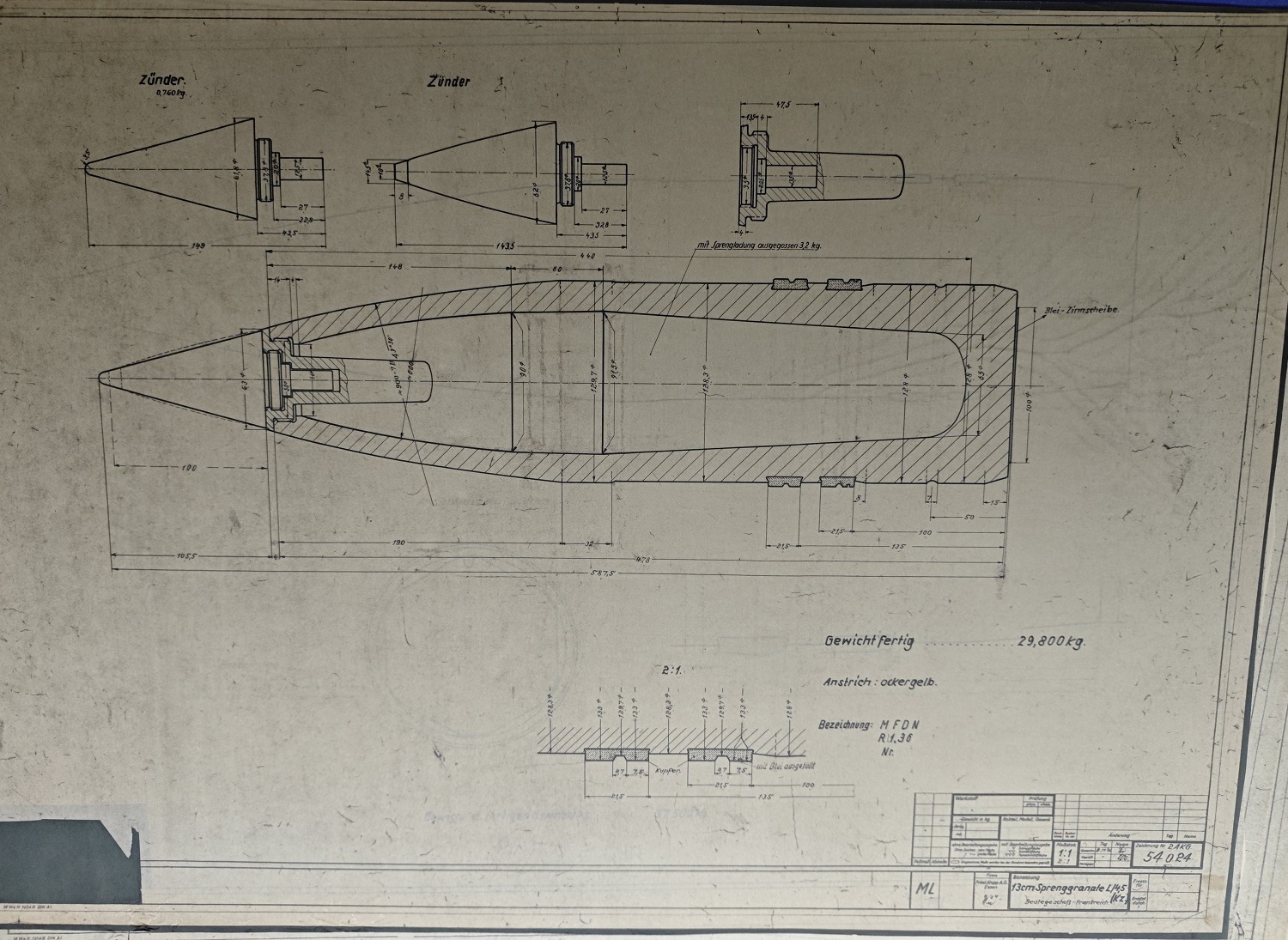
The Model 1932 was specifically designed for the Dunkerque class and was the first dual-purpose (DP) gun ever used as secondary armament on a capital ship. The guns were used in three quad and two twin mounts. The quad mount version of these guns was similar to the 330 mm (13") main guns in that they were really two dual gun mounts merged into a single turret. This DP design was not successful, as the very complicated semi-automatic loading mechanism was prone to jamming. In addition, the very high weight of the fixed ammunition led to rapid crew fatigue and much slower rates of fire.
The Model 1935 was a SP gun used on the first eight units of the Le Hardi destroyer class. Only two of these ships, Le Hardi and Fleuret, were close to being completed before the Armistice. These two destroyers plus L'Epée were eventually completed and formed the 10th Division de Torpilleurs, but there is evidence that their armament was not fully functional. In an engagement with the British destroyer Hotspur on 25 September 1940, L'Epée fired only fourteen shots before all of her 130 mm guns developed defects and were rendered useless. In this same engagement, Fleuret did not fire a shot as her fire control equipment could not follow the target. However, Le Hardi at Dakar the previous day fired 60 rounds without suffering a breakdown and was able to bracket her target with her first salvo.
In 1938, consideration was given to arming the last eight units of the Le Hardi class with the DP Model 1932 in order to improve their AA capability. None of these ships were completed before the Armistice.
Used an autofretted barrel and a breech ring. The breech block was vertically sliding in the DP version but horizontally sliding in the SP version. Both breech mechanisms were semi-automatic.
| Designation | 130 mm/45 (5.1") Models 1932 and 1935 |
|---|---|
| Ship Class Used On | Model 1932: Dunkerque and Joffre classes
Model 1935: Le Hardi Classes |
| Date Of Design | 1932 / 1935 |
| Date In Service | 1937 / 1939 |
| Gun Weight | 3.75 tons (3.81 mt) |
| Gun Length oa | 245. 9 in (6.245 m) |
| Bore Length | 232.2 in (5.899 m) |
| Rifling Length | 198.8 in (5.049 m) |
| Grooves | N/A |
| Lands | N/A |
| Twist | Uniform RH 1 in 25.59 |
| Chamber Volume | 811.1 in3 (13.292 dm3) |
| Rate Of Fire | Model 1932: 10 - 12 rounds per minute
Model 1935: 10 - 15 rounds per minute |
| Type | Fixed |
|---|---|
| Weight of Complete Round | 116.8 lbs. (53.0 kg) |
| Projectile Types and Weights 1 2 | SAP M1933: 70.8 lbs. (32.1 kg)
HE M1934: 65.1 lbs. (29.5 kg) 3 Starshell: N/A |
| Bursting Charge | SAP M1933: about 3.5 lbs. (1.6 kg)
HE M1934: about 7 lbs. (3.2 kg) |
| Projectile Length | SAP M1933: 25.5 in (64.8 cm)
HE M1934: 23 in (58.3 cm) Complete SAP round: 53.1 in (134.9 cm) Complete HE round: 50.7 in (128.4 cm) |
| Propellant Charge | 19.3 lbs. (8.76 kg) BM9 |
| Muzzle Velocity | SAP M1933: 2,625 fps (800 mps)
HE M1934: 2,756 fps (840 mps) |
| Working Pressure | 17.1 tons/in2 (2,700 kg/cm2) |
| Approximate Barrel Life | about 900 rounds |
| Ammunition stowage per gun | Dunkerque: 400 rounds 4 5 Le Hardi: 170 rounds 6 |
- ^
Actual French designations SAP M1933 OPfK Mle 1933 HE M1934 OEA Mle 1934 Starshell OEcl Mle 1934 - ^The sources below disagree as to projectile weights. I have chosen to use those given in "French Battleships: 1922 - 1956" and "Naval Weapons of World War Two."
- ^The HE Model 1934 was supplied with contact, delayed contact and time fuzes. These all had different weights, which affected the total shell weight.
- ^Outfit for Dunkerque as completed consisted of 2,000 SAP and 4,400 HE and Starshell.
- ^Ready ammunition in the quad mount rotating structure was 32 AA rounds and 16 surface rounds.
- ^Outfit for Le Hardi was 1,020 SAP rounds and 60 starshell.
| Elevation | 70.77 lbs. (32.1 kg) HE | 70.8 lbs. (32.1 kg) SAP | 64.9 lbs. (29.5 kg) AA |
|---|---|---|---|
| 45 degrees | 22,750 yards (20,800 m) | 22,820 yards (20,870 m) | --- |
| AA Ceiling @ 75 degrees | --- | --- | About 40,000 feet (12,000 m) |
| Designation | Twin DP Mounts 1a Dunkerque (2) and Joffre (4): Model 1932 Quad DP Mounts 2a 1a Twin SP Mounts 3a |
|---|---|
| Weight | Twin DP: 79.9 tons (81.2 mt)
Quad DP: 197 tons (200 mt) Twin SP: 32.1 tons (32.6 mt) |
| Elevation | DP Mounts: -10 / +75 degrees
SP Mounts: -10 / +35 degrees (see mounting sketch below) |
| Rate of Elevation | DP Mounts: 6 degrees per second (one source says 8 degrees per second) |
| Train | Dunkerque
Lateral Quads: 175 degrees total Lateral Twins: 171 degrees total Centerline Quad: -150 / +150 degrees Le Hardi: About -150 / +150 degrees |
| Rate of Train | 12 degrees per second |
| Gun Recoil | DP: 16.5 in (42 cm)
SP: 20 in (50 cm) |
| Loading Angle | DP: Any angle
SP: Any angle up to +30 degrees |
- ^1.11.2The DP mountings had a double hoist for each gun, one for AA rounds and one for surface rounds. Rounds were passed by hand to the hoists which came up by the outer cradle trunnions of each pair and the rounds were passed to the loading tray by a combination of hydraulically powered tilting and rotating trays and slide tracks. Rammers were pneumatic with the breech closing automatically after ramming. Firing automatically ejected the cartridge case onto the loading tray after which it was manually passed onto a conveyor. The distance between gun axes for the Quad DP mount was 21.7 in (55 cm) between pairs and 96.5 in (245 cm) between the inner guns. Gun axes distance is unavailable for the Twin DP mount but is said to have been greater than that for the quad mount. There was a 0.8 in (2 cm) bulkhead extending about 65% of the turret length between the gun pairs. Training and elevation were both powered by 10 hp motors with Sautter-Harlé RPC.
- ^The quadruple mountings were developed by St. Chamond and do not appear to have been very successful, with the loading system in particular being prone to defects.
- ^The SP mountings were a base-ring type. The pusher hoists did not rotate with the mounting and instead fed a rotating tipping drum called a barillet de reception. The pusher hoists delivered four complete rounds (two per gun) to the drum where they compressed a set of springs and the drum then rotated to conform with the training angle of the mounting. The drum then tipped over horizontally and the springs pushed the rounds out onto upper and lower loading trays for each gun. Each gun had a powered rammer which proved to be underpowered and jams and breakdowns in the loading mechanisms were frequent. Gun shields were of the open-back type. Electric power was used for training and elevation. The distance between gun axes was 51.2 in (130 cm).




"Naval Weapons of World War Two" by John Campbell
"Battleships: Allied Battleships in World War II" by W.H. Garzke, Jr. and R.O. Dulin, Jr.
"French Battleships: 1922 - 1956" by John Jordan and Robert Dumas
"French Destroyers: Torpilleurs d'Escadre & Contre-Torpilleurs 1922 - 1956" by John Jordan and Jean Moulin
"Destroyers of World War Two" and "Battleships of World War Two" both by M.J. Whitley
---
Email correspondence with John Jordan on 21 October 2019
16 May 2006 - Benchmark
09 July 2009 - Added comment about 25 September 1940 action
30 November 2009 - Added information on projectiles
25 February 2012 - Added stern picture of Le Hardi
14 September 2015 - Redid photograph of Le Hardi, additional information on guns, ammunition and mountings
21 October 2019 - Converted to HTML 5 format, added mounting sketch
18 December 2024 - Added German sketch of OEA Mle 1934
